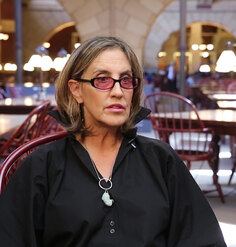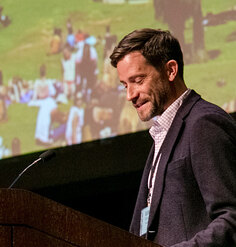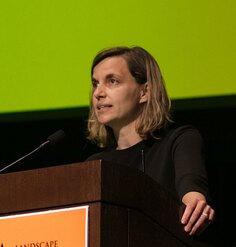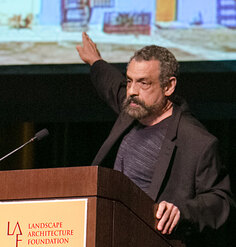Regenerative Infrastructure Systems Through Urban Acupuncture
By Tim Duggan
This presentation was part of the Landscape Architecture Foundation’s The New Landscape Declaration: A Summit on Landscape Architecture and the Future held in Philadelphia on June 10-11, 2016. LAF asked a diverse group of leading minds to write a “Declaration” reflecting on the last half century and offering bold ideas for how landscape architecture can make its vital contribution in response to the challenges of our time.
Tim Duggan
Founding Partner, Phronesis
Kansas City, Missouri
Tim Duggan is founding partner of Phronesis with offices in Kansas City and New Orleans. Phronesis is a landscape architecture and urban design studio focused almost entirely on creating regenerative infrastructure and community systems within the public realm.
* Affiliation at the time of the Summit
Regenerative Infrastructure Systems Through Urban Acupuncture
by Tim Duggan
The twentieth-century transportation network created substantial challenges for many communities across the country, and we face significant aging infrastructure and economic development challenges for the twenty-first century. Together, local, state, and federal governments have set about on a frenzy of urban renewal projects through brazen demolition and bold, yet sometimes ill-advised, construction of infrastructure, buildings, and roads. The coordinated effort that built our modern highway system and provided quick access to and from a majority of urban cores had several unintended consequences that emerged over time. This approach, unfortunately, also left a legacy of isolation in its wake for many low- to moderate-income communities, with readily apparent neglect across our urban landscape. More importantly, these infrastructure systems are not sustainable and should not simply be replicated with infrastructure that is copied and pasted from the last 100 years. Infrastructure systems need to be designed with multiple positive outcomes through innovative processes, with the goal of developing more regenerative infrastructure solutions.
Having internalized these lessons of the past, landscape architects are at a crossroads where they can either maintain the status quo or elbow their way to the “decision-makers” table and help establish a new paradigm for solving this current set of problems. Our profession needs to help shift patterns in the way that city infrastructure systems are planned, designed, and operated and adapt them to how present-day residents live, work, and play. These systems must be integrated into the natural environment in a more sustainable manner.
The shift should begin at the urban core and focus on making existing blighted communities and abandoned brownfield landscapes into healthier, walkable, resource-rich, and well-connected communities. Simultaneously, the profession needs to demand wholesale change in the decision-making and design process from the previously applied limited resources and funding mechanisms—from scattered sites and piecemeal system improvements into highly strategic node-based redevelopment initiatives. If we truly want to overcome blight and disinvestment in the marginalized sections of our cities, landscape architects will need to be more strategic and creative with our approach to designing infrastructure systems across the country. This planning approach to creating regenerative infrastructure systems that can leverage multiple community benefit outcomes has been referred to as urban acupuncture by Jaime Lerner, Bob Berkebile, and others.
Streets once designed for horse carts must now safely carry cars, buses, freight, digital utilities, stormwater, wastewater, cyclists, and pedestrians. In areas where growth has yet to arrive, the existing transportation infrastructure fails to provide nodes and corridors that are sustainable into the future. We can no longer let the automobile make every decision in the built environment.
Landscape architects need to orchestrate regenerative infrastructure initiatives that are centered around safe, healthy, walkable, digitally connected, resource-rich environments with a goal of driving systemic change within our communities and leveraging our limited infrastructure resources for the next 100 years. This broad understanding of systems-based thinking can empower the profession to coordinate large-scale infrastructure opportunities like transit-oriented development, affordable housing, and mixed-use development, as well as leverage those limited resources into very strategic urban revitalization outcomes.
Landscape architects must take a unique approach in how we seek ways to collaborate, engage, design, and leverage these existing opportunities into regenerative infrastructure solutions. These projects have the opportunity to redefine infrastructure in America for the next 100 years. By harnessing all the opportunities of these projects, a new vision can be realized with the collective experience in planning, designing, and implementing sustainable solutions locally and across the country. The diversity of project experiences in these infrastructure systems makes our profession uniquely qualified to be the leaders in those efforts.
This approach can only be accomplished through a highly collaborative process rooted in technical understanding, community engagement, and stakeholder involvement. The broad understanding of systems-based design and collaboration is the heart of landscape architecture, a profession that can efficiently help redefine the urban landscape and assist in the development of effective, transformative models for regenerative infrastructure and public landscapes across the country.
We know from experience that big visions are actually easier to accomplish than their less popular cousin—the “not-so-interesting vision.” However, big visions have to be grounded in a deep understanding of physical and market constraints with real data. This holistic approach will form a complete solution and encourage the fusion of regenerative infrastructure systems for the next generation that is uniquely its own.
I understand that these project types present unique opportunities and constraints to redefine this paradigm within our profession and I am a willing partner in that collaboration.











